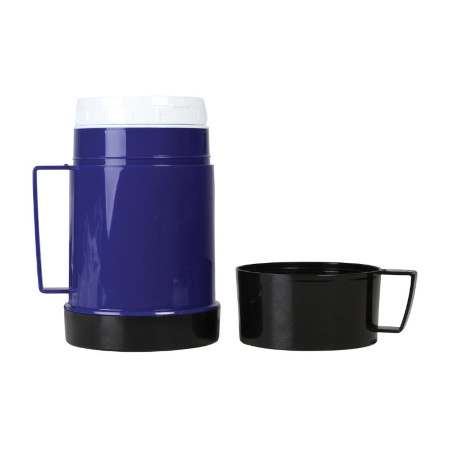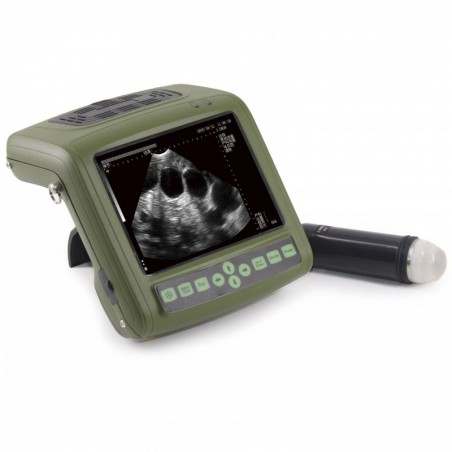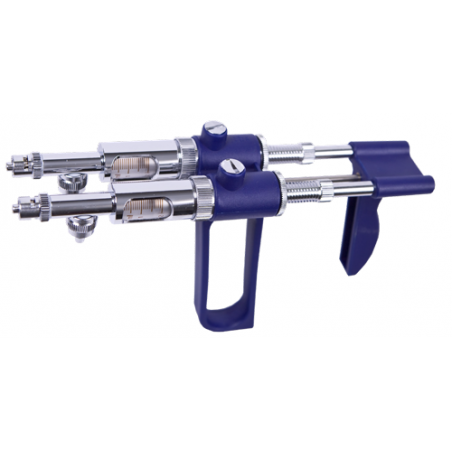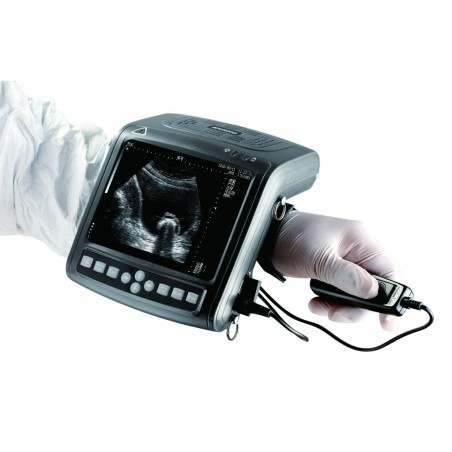Farm description
The farm is located in the Po valley in northern Italy. It has 1,400 sows and sells piglets weighing 35-40 kg. It is free of Aujeszky's disease, but positive for PRRSv, M. hyo and App. Sows are immunised as follows:

- Aujeszky: 3 times a year (applied together with the influenza vaccine in 2 out of the 3 times)
- E. Coli and rhinitis: 2 vaccinations in gilts in the second third of gestation
- Erysipelas and parvovirus: in the farrowing pen the week prior to weaning
- PRRS: applied in accordance with the program 6-60 (6 days post-farrowing and 60 days of gestation)
Replacements are introduced weighing 30 kg and being negative for PRRS. They are housed in facilities up to about 50 kg away from the farm and subsequently moved to the farm, but still kept isolated and in an all-in / all-out system.
First occurrence
The farm reports a problem of low prolificacy: the average live birth weight in 2015 was 11.91. The number of live births is low, regardless of the parity (Table 1.)
Table 1. Number of piglets born in 2015 by parity.
| Cycle | Total born | Live births | Stillbirths |
| 1 | 11.19 | 10.67 | 0.52 |
| 2 | 11.96 | 11.58 | 0.38 |
| 3 | 12.71 | 12.31 | 0.40 |
| 4 | 13.36 | 12.69 | 0.67 |
| 5 | 13.42 | 12.54 | 0.88 |
| 6 | 13.36 | 12.35 | 1.01 |
| 7 | 13.24 | 11.92 | 1.32 |
| ≥8 | 12.89 | 11.64 | 1.25 |
| 12.62 | 11.91 | 0.71 |
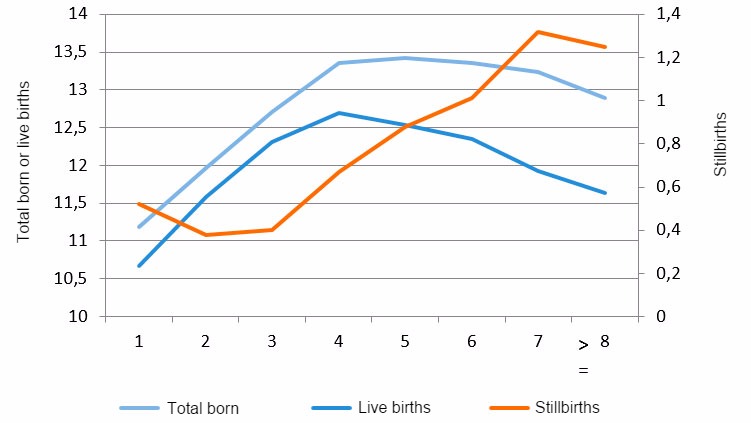
The number of mummified piglets in gilts is slightly higher than normal (3.7%), but in general, it can be stated that the number of piglets conceived is strangely low. The clinical picture described contrasts with a high ultrasound fertility, although the farrowing rate falls in the summer.
Summer brings a worsening of the problems related to the resorption that occurs even after the ultrasound diagnosis. In some cases, early abortions are observed, while in others, empty sows are identified in the pens without a previous diagnosis of abortion. Table 2 shows the monthly fertility and farrowing rate results.
Table 2: 2015 monthly results for ultrasound fertility and farrowing rate.
| Jan | Feb | Mar | Apr | May | Jun | Jul | Aug | Sep | Oct | Nov | Dec | |
| Ultrasound fertility (%) | 93.2 | 92.5 | 91.5 | 90.3 | 91.5 | 89.5 | 83.2 | 82.2 | 84.4 | 86.2 | 92.1 | 93.4 |
| Farrowing rate (%) | 90.1 | 88.4 | 87.1 | 86.4 | 86.1 | 85.3 | 71.1 | 68.3 | 70.1 | 80.8 | 89.9 | 91.2 |
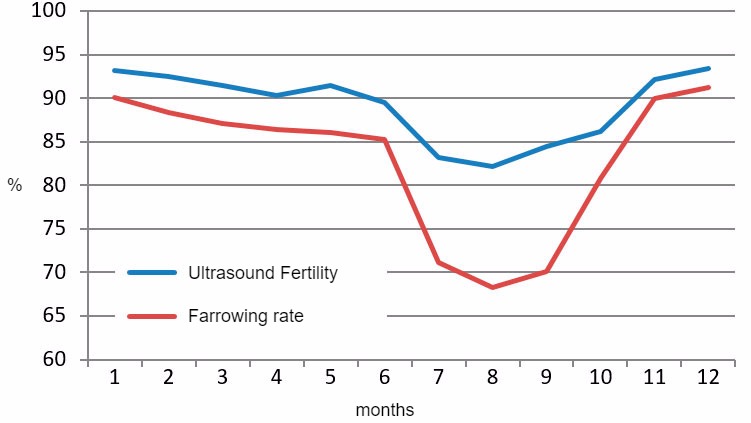
In the distribution of the cyclic and acyclic returns, a deviation towards the acyclic is also observed, which is obviously a warning signal, even though there are no clinical manifestations on the farm that suggest the presence of health problems. Obviously, the percentage of acyclic returns increases considerably in summer, when infertility is at its highest. Lab tests have been carried out for pathologies that may interfere with fertility and prolificacy, but their results have been negative. Figures 3 and 4 shows how returns are distributed in the favourable period (between October and June) and in the summer months (between July and September). In general, acyclic returns tend to be higher than expected, with a marked summer worsening of the ratio between cyclic and acyclic returns.
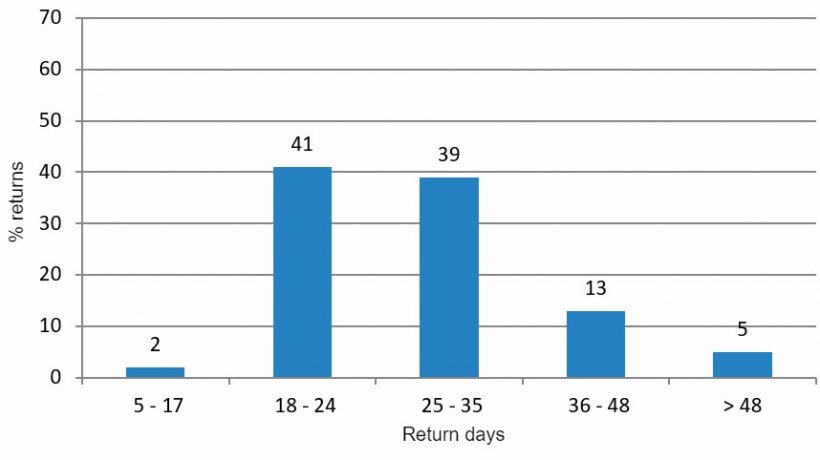
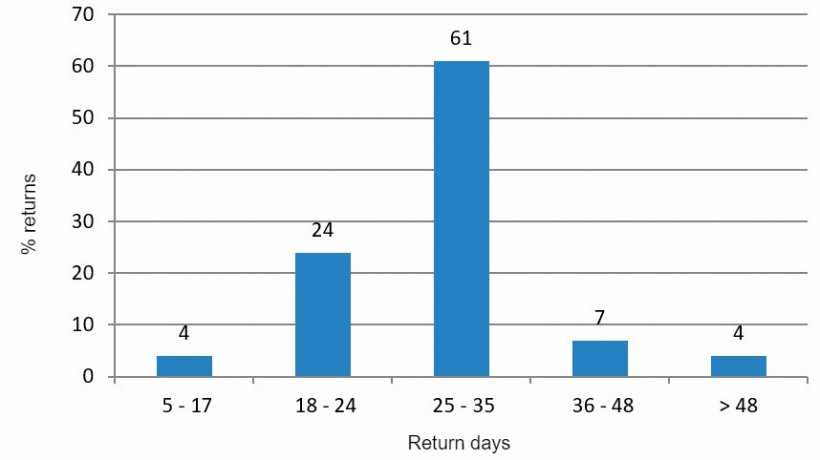
Case discussion
The first thing we decide to verify is the accuracy of the ultrasound diagnosis. The farm staff performs two ultrasounds. The first one is performed between days 23 and 29 of gestation, and the second one at day 40. As mentioned above, gestations are lost between the first and second ultrasound: early abortions are seen or, in some cases, the sow is empty in the second ultrasound and no previous abortion is detected in the interim. After ensuring the ultrasound scans are carried out correctly, we evaluate heat detection, and insemination timing and technique, which are also correct. We also check that room staff correctly record the number of piglets born alive, dead, mummified and crushed at the time of farrowing.
It is at this point the idea begins to form that the low number of piglets born may be related to a premature entry into the pens after fertilization. It is suspected that during a good part of the year, when the environmental stress is lower, the sows continue to get pregnant, although they end up farrowing a relatively low number of piglets. Other times, like in the summer, established gestations are lost, which could explain the large number of acyclic returns.
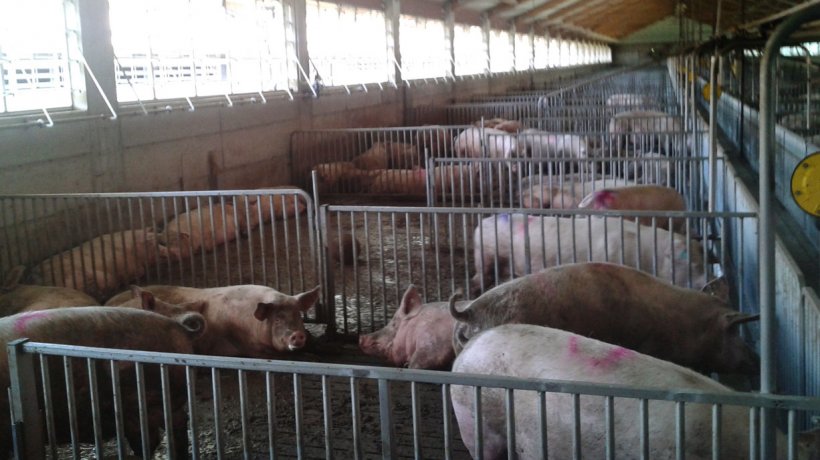
This theory can also explain the fact that in the most favourable periods of the year the fertility and farrowing rates are excellent, whereas the number of piglets born is unsatisfactory.
Each group of sows includes between 16-18 animals, although they can have up to 28-30 animals. Sows are fed twice a day, morning and afternoon.
Tests performed
Before considering the creation of a new space where all sows in crates can be housed during the first 4 weeks of gestation —as already contemplated in EU animal welfare legislation—, it is decided, together with owners and management, to change the use of the crates present on the farm. These crates were used to house weaned sows until service; after this time point, the animals were moved to the pens so that the new weaned sows could occupy the same crates.
As a consequence of the hypotheses formulated, we decide to wean the sows directly in the pens, and 1 (weekly) out of 4 batches is taken to the crates at the time of service, where it remains during the first 28 days of gestation. Of course, the other batches are weaned and serviced in the pens.
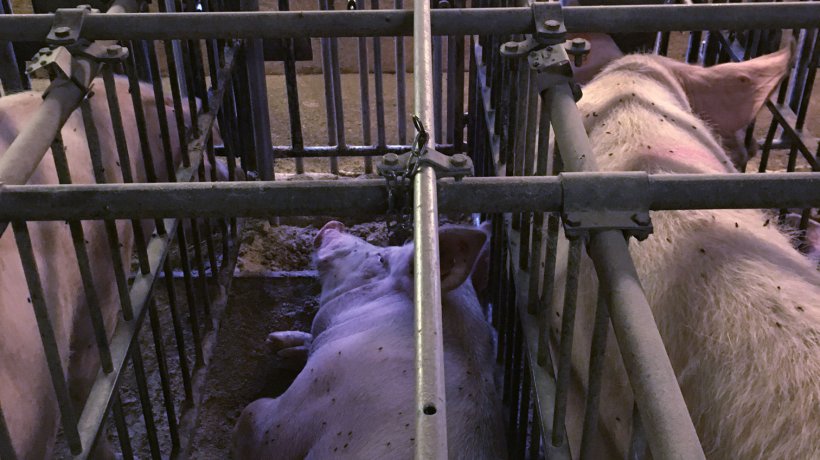
Case development
As of December 2015, the 3 batches which their whole gestation developed in the pens start to alternate with the batch that is kept in crates from fertilization until day 28 of gestation.
The ultrasound results and the farrowing rates of the batches that are already full term at the time of writing, present an optimal percentage of fertility and farrowing rates, which is normal for this farm outside the summer period (see Figure 5).
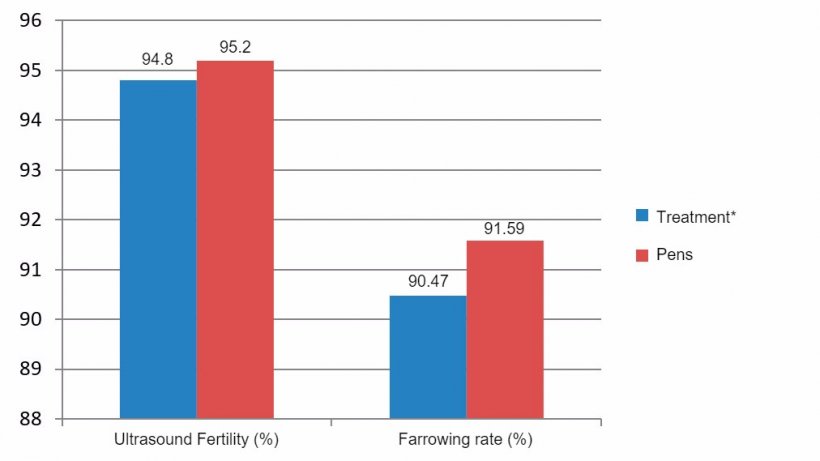
The most interesting aspect is the born piglets, as shown in Figure 6. In fact, the sows that remained in the crates until day 28 post-insemination recorded 1 piglet born more than the ones that were weaned and serviced in pens (13.84 vs 12.80 total born).
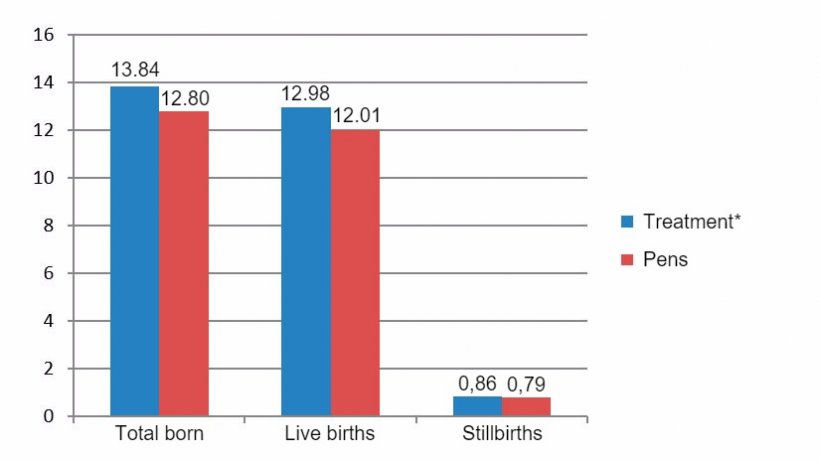
The difference is even greater in primiparous. Although these show no differences in fertility or farrowing rates, a difference of 1.55 piglets was found in the number of total born (13.04 vs 11.49), suggesting that replacements are probably more sensitive to the effect of an early entry into the pen (often mixed with multiparous because of the high density in the pens). Figures 7 and 8 summarizes the primiparous data.
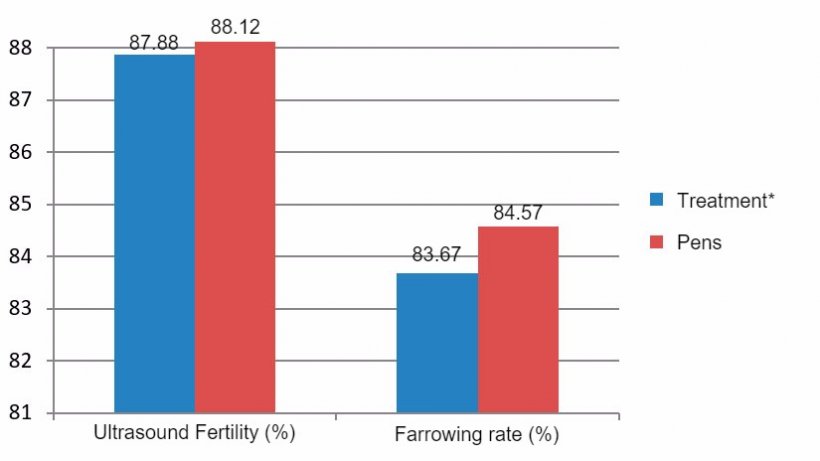
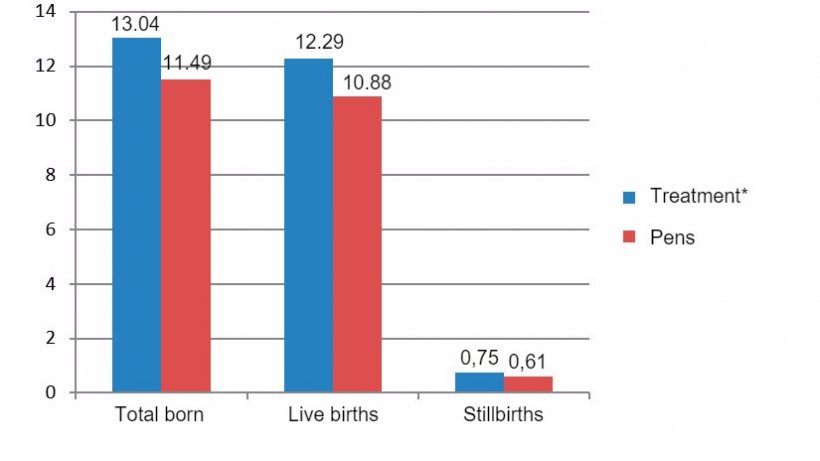
Data from the summer months are also interesting: the sows that spent the first 4 weeks in crates did not show the classic fertility reduction and did not manifest resorptions or acyclic returns. On the other hand, even though they presented less returns than in 2015, some weeks the sows that were serviced and spent all their gestation in the pens exceeded 10%.
Table 3: Evolution (crates vs. pens) of fertility at first and second ultrasound in the summer months.
| Week | Location (crate/pen) | 1st ultrasound fertility | 2nd ultrasound fertility |
| 28-2016 | C | 94.61 | 91.44 |
| 29-2016 | P | 92.12 | 89.42 |
| 30-2016 | P | 90.1 | 84.19 |
| 31-2016 | P | 98.28 | 94.83 |
| 32-2016 | P | 89.56 | 78.25 |
| 33-2016 | C | 91.35 | 87.04 |
| 34-2016 | P | 90.67 | 83.44 |
| 35-2016 | P | 89.61 | 84.51 |
| 36-2016 | P | 86.34 | 73.56 |
| 37-2016 | P | 90.23 | 87.35 |
| 38-2016 | C | 92.77 | 88.89 |
| 39-2016 | P | 91.6 | 86.4 |
| 40-2016 | P | 88.43 | 83.9 |
| 41-2016 | P | 93.45 | 90.18 |
Two factors have to be taken into account: the summer of 2016 was not as hot as the previous one and, as a consequence of the analysis of the first results, greater care was taken in the formation of the groups, trying to reduce densities (below the provisions of animal welfare regulations) and to group animals according to weight and size. On the other hand, to make the animals more comfortable, especially during the delicate period of embryonic implantation, we decided to feed the sows once a day. This practice is obviously maintained during the rest of the gestation. To improve the sows' feeling of fullness during the first month of gestation, the amount of feed has also been increased by 10-15%. As gestation progresses, it is progressively reduced, so that in the end they receive, approximately, the same amount of feed.
Conclusion
At the time of writing this article, the number of piglets born as a result of the summer services is still not known. As described above, a smoother summer together with the measures taken on the groups of sows that used to spend all their gestation in yards, have reduced the acyclic returns and the resorptions with respect to the previous year.
We are waiting for the results regarding the number of piglets born to decide whether it is worth investing in the construction of a new gestation room with crates to keep the sows in during the first 4 weeks (which has generated an improvement of the total of: + 1 piglet born), or whether the implemented strategies will be kept in pens throughout gestation.





